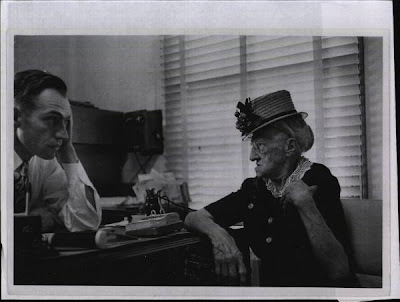
This (above) is one of my all-time favorite movie stills: Marie Dressler as the dowager in "Dinner at Eight." One of these days I'll frame this so I can have it on my desk in whatever office I'm working in.

Of course I'll have to dress like this (above), so I can play my part. That's me playing Max Fleischer in a photo essay I did last year.

The idea is to pass the desk picture off as being my wife. My real wife doesn't look or act this way at all, but she'll have to take an undeserved fall, because in classic cartoons middle-aged men are always married to battle axes who they address as "Schnookums," and "Sweetie Puss."
I'm a cartoonist, so the tradition must be honored.

Writing about this age thing got me to thinking about the subject of grey hair and how aging affects the face.

Writing about this age thing got me to thinking about the subject of grey hair and how aging affects the face.

I only have womens' pictures to illustrate this, so I'll pick on them. Most women don't know how to to make their faces look good after 40.

...but when you get older (above) your face tends to flatten out. This coincides with the skin becoming dry and wrinkled. Women ignore the face flattening and try to compensate for the skin problem by layering on tons of make-up, but this comes from a misunderstanding of the problem.

The main problem isn't wrinkles, it's the flattening of the face. A flat face does even more than wrinkles to make you look older ("older" as I use it here doesn't refer to the characteristics of extreme old age, which are different). Putting on lots of make-up (above) only makes that worse. The extra color evens out the facial color and makes it seem even more flat and featureless. Worse yet, women compensate for the enhanced flatness by putting extra make-up on the eyes, something that doesn't work at all. The diversion is too obvious, too artificial.


The odd thing is that nature already compensates for wrinkles by making middle-aged flesh more textured and ruddy. The increased and uneven texture takes the observer's eye to interesting places all around the face, and prevents him from seeing the overall flattening. Nature gave middle-aged women ruddy faces to compensate for the wrinkles, but a lot of women refuse the gift.

Middle-aged women also need to re-discover grey hair. Grey makes the skin seem even ruddier by contrast, and that makes the face look younger. I know what you're thinking; grey hair is universally recognized as a sign of aging. That's true, but it's also true that people who look at you close up will judge your age more by the face than the hair. Grey hair may be an attempt by nature to prolong beauty, not put an end to it.

Before I leave this subject, I can't resist reminiscing about old ladies I've known. When I was a kid I encountered a lot who struck me as mean and frightening. Oddly enough, when I got to be an older teenager I saw fewer women like this. I think it's because I stopped doing the things that irritated them, and began to see their sweeter side.

I was born too late to see old ladies with waxed fruit on their hats (above), but I did see quite a few who had other kinds of cartoony hats, and I got to see lots of Olive Oyle dresses. They were mostly nice people with incredibly sunny dispositions. They had lots of friends their own age, and weren't stay-at-homes unless they were forced to be. They worked hard, had enormous dignity, and were universally respected.


















































